Occupational Health Management Plan for Hazardous Drug Exposure
VerifiedAdded on 2022/11/17
|14
|3098
|196
Report
AI Summary
This report details an occupational health management plan for a pharmaceutical company, focusing on hazardous drug exposure. It begins with an introduction to occupational health hazards and their implications, followed by a detailed description of the workplace, including the nature of the work, employee demographics, and exposure duration. The report identifies occupational health hazards and associated risks, specifically highlighting the dangers of drug exposure, including carcinogenic properties, organ toxicity, and reproductive issues. The issue is analyzed, considering legal and ethical implications, and current management measures are evaluated. The core of the report proposes a comprehensive occupational health program, which includes employee training, communication plans, and performance indicators to monitor the program's effectiveness. The program aims to reduce the impact of hazardous drug exposure and improve worker health outcomes. The report concludes by emphasizing the importance of continuous communication, training, and compliance with hazard management plans to ensure employee safety and well-being within the pharmaceutical workplace.
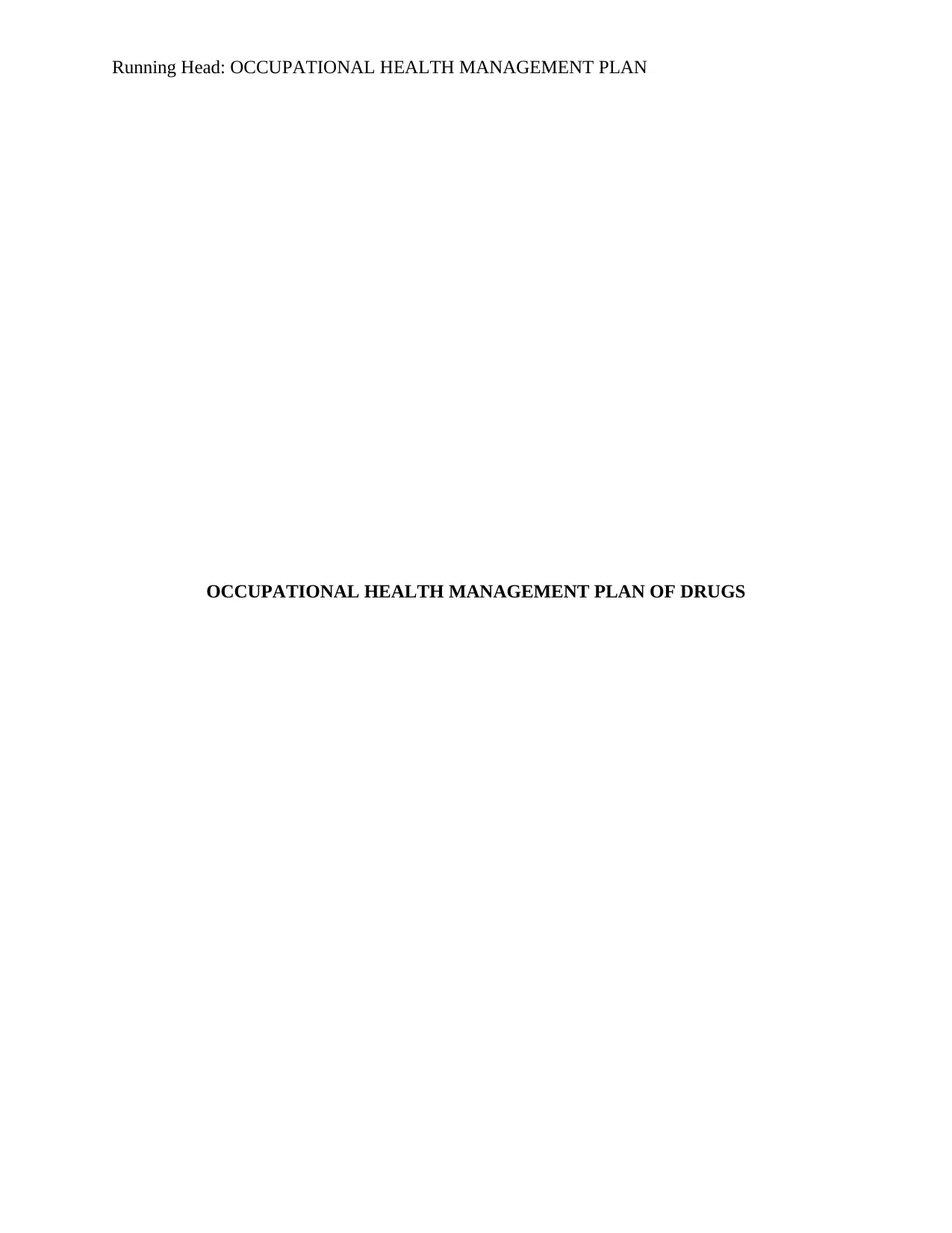
Running Head: OCCUPATIONAL HEALTH MANAGEMENT PLAN
OCCUPATIONAL HEALTH MANAGEMENT PLAN OF DRUGS
OCCUPATIONAL HEALTH MANAGEMENT PLAN OF DRUGS
Paraphrase This Document
Need a fresh take? Get an instant paraphrase of this document with our AI Paraphraser
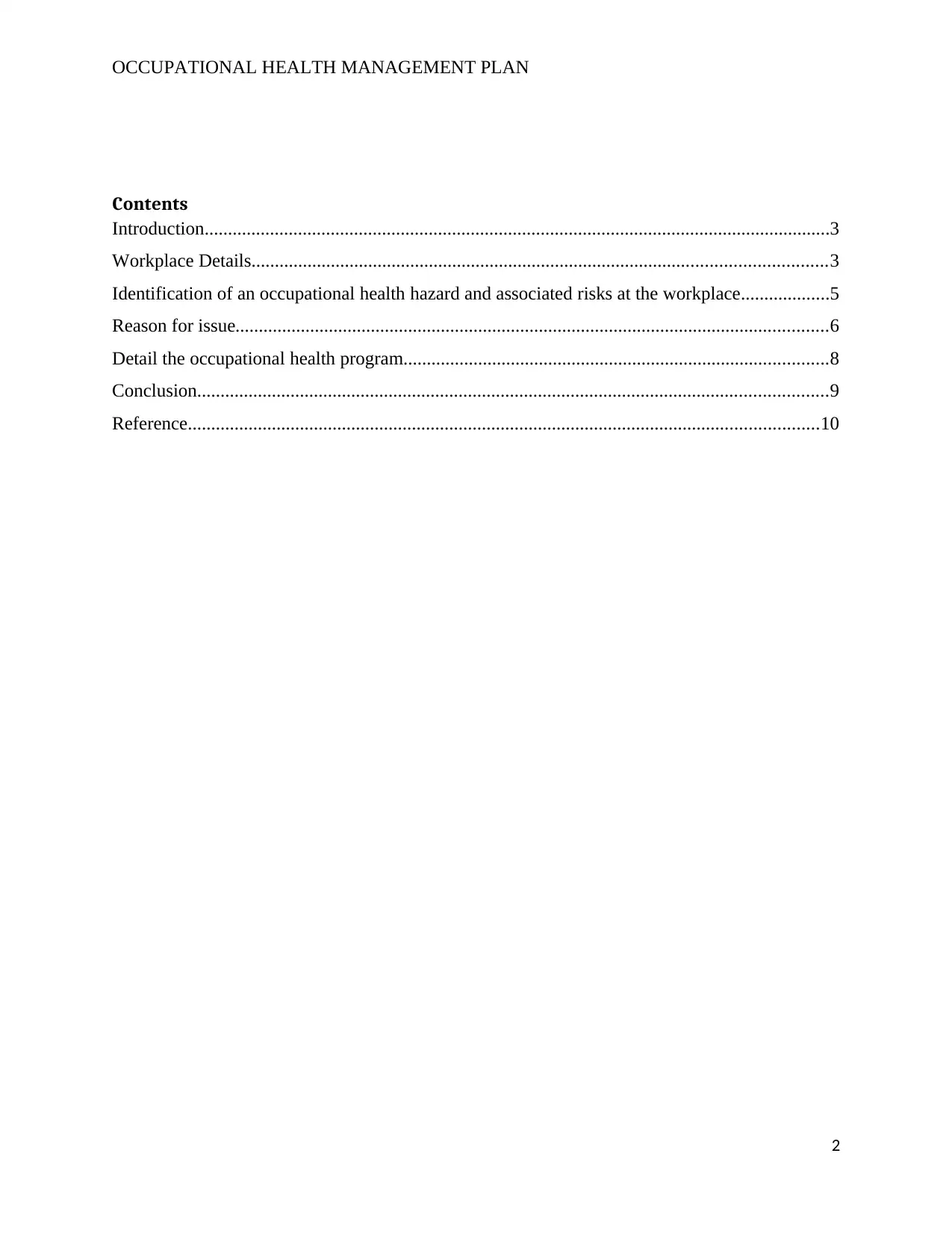
OCCUPATIONAL HEALTH MANAGEMENT PLAN
Contents
Introduction......................................................................................................................................3
Workplace Details...........................................................................................................................3
Identification of an occupational health hazard and associated risks at the workplace...................5
Reason for issue...............................................................................................................................6
Detail the occupational health program...........................................................................................8
Conclusion.......................................................................................................................................9
Reference.......................................................................................................................................10
2
Contents
Introduction......................................................................................................................................3
Workplace Details...........................................................................................................................3
Identification of an occupational health hazard and associated risks at the workplace...................5
Reason for issue...............................................................................................................................6
Detail the occupational health program...........................................................................................8
Conclusion.......................................................................................................................................9
Reference.......................................................................................................................................10
2
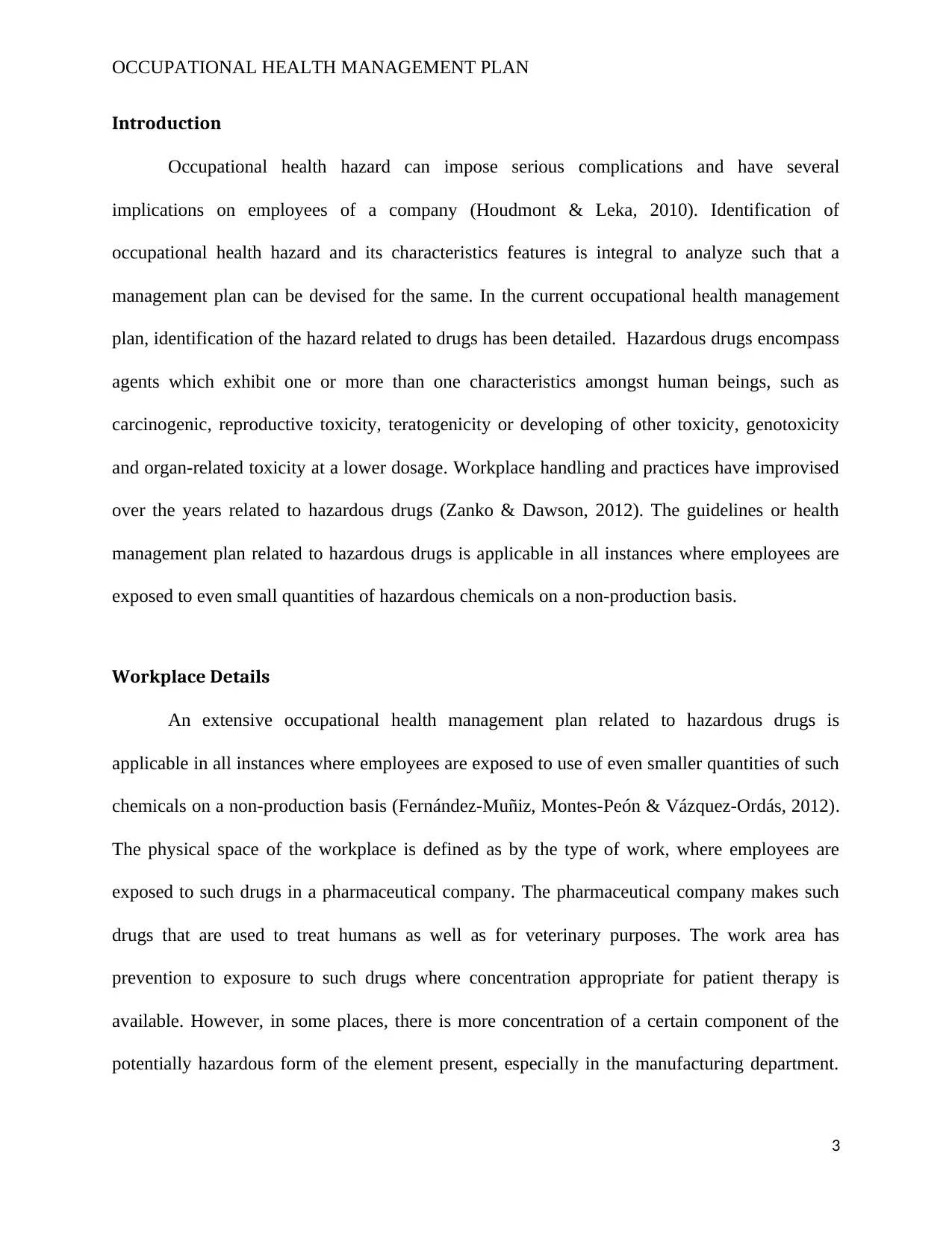
OCCUPATIONAL HEALTH MANAGEMENT PLAN
Introduction
Occupational health hazard can impose serious complications and have several
implications on employees of a company (Houdmont & Leka, 2010). Identification of
occupational health hazard and its characteristics features is integral to analyze such that a
management plan can be devised for the same. In the current occupational health management
plan, identification of the hazard related to drugs has been detailed. Hazardous drugs encompass
agents which exhibit one or more than one characteristics amongst human beings, such as
carcinogenic, reproductive toxicity, teratogenicity or developing of other toxicity, genotoxicity
and organ-related toxicity at a lower dosage. Workplace handling and practices have improvised
over the years related to hazardous drugs (Zanko & Dawson, 2012). The guidelines or health
management plan related to hazardous drugs is applicable in all instances where employees are
exposed to even small quantities of hazardous chemicals on a non-production basis.
Workplace Details
An extensive occupational health management plan related to hazardous drugs is
applicable in all instances where employees are exposed to use of even smaller quantities of such
chemicals on a non-production basis (Fernández-Muñiz, Montes-Peón & Vázquez-Ordás, 2012).
The physical space of the workplace is defined as by the type of work, where employees are
exposed to such drugs in a pharmaceutical company. The pharmaceutical company makes such
drugs that are used to treat humans as well as for veterinary purposes. The work area has
prevention to exposure to such drugs where concentration appropriate for patient therapy is
available. However, in some places, there is more concentration of a certain component of the
potentially hazardous form of the element present, especially in the manufacturing department.
3
Introduction
Occupational health hazard can impose serious complications and have several
implications on employees of a company (Houdmont & Leka, 2010). Identification of
occupational health hazard and its characteristics features is integral to analyze such that a
management plan can be devised for the same. In the current occupational health management
plan, identification of the hazard related to drugs has been detailed. Hazardous drugs encompass
agents which exhibit one or more than one characteristics amongst human beings, such as
carcinogenic, reproductive toxicity, teratogenicity or developing of other toxicity, genotoxicity
and organ-related toxicity at a lower dosage. Workplace handling and practices have improvised
over the years related to hazardous drugs (Zanko & Dawson, 2012). The guidelines or health
management plan related to hazardous drugs is applicable in all instances where employees are
exposed to even small quantities of hazardous chemicals on a non-production basis.
Workplace Details
An extensive occupational health management plan related to hazardous drugs is
applicable in all instances where employees are exposed to use of even smaller quantities of such
chemicals on a non-production basis (Fernández-Muñiz, Montes-Peón & Vázquez-Ordás, 2012).
The physical space of the workplace is defined as by the type of work, where employees are
exposed to such drugs in a pharmaceutical company. The pharmaceutical company makes such
drugs that are used to treat humans as well as for veterinary purposes. The work area has
prevention to exposure to such drugs where concentration appropriate for patient therapy is
available. However, in some places, there is more concentration of a certain component of the
potentially hazardous form of the element present, especially in the manufacturing department.
3
⊘ This is a preview!⊘
Do you want full access?
Subscribe today to unlock all pages.

Trusted by 1+ million students worldwide
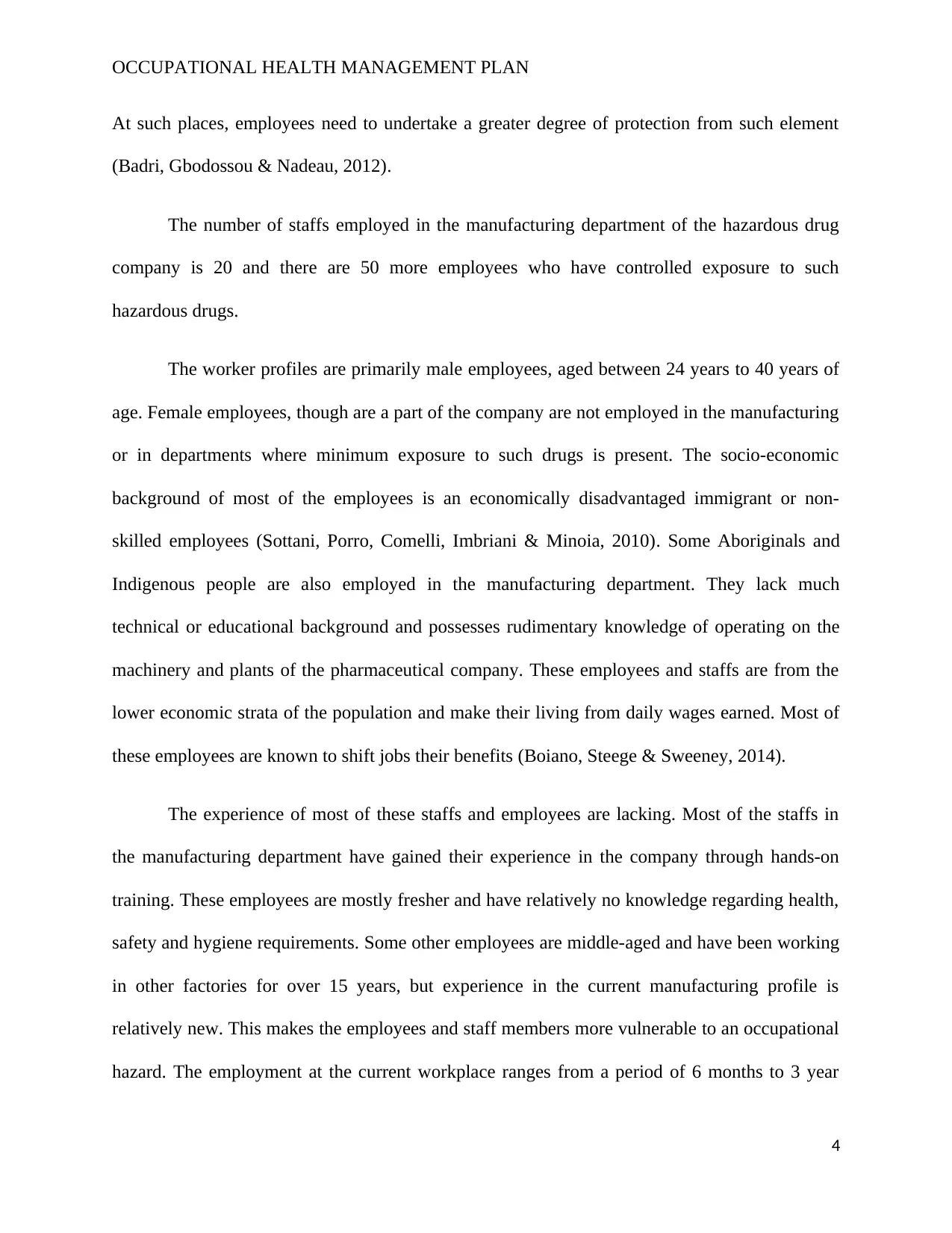
OCCUPATIONAL HEALTH MANAGEMENT PLAN
At such places, employees need to undertake a greater degree of protection from such element
(Badri, Gbodossou & Nadeau, 2012).
The number of staffs employed in the manufacturing department of the hazardous drug
company is 20 and there are 50 more employees who have controlled exposure to such
hazardous drugs.
The worker profiles are primarily male employees, aged between 24 years to 40 years of
age. Female employees, though are a part of the company are not employed in the manufacturing
or in departments where minimum exposure to such drugs is present. The socio-economic
background of most of the employees is an economically disadvantaged immigrant or non-
skilled employees (Sottani, Porro, Comelli, Imbriani & Minoia, 2010). Some Aboriginals and
Indigenous people are also employed in the manufacturing department. They lack much
technical or educational background and possesses rudimentary knowledge of operating on the
machinery and plants of the pharmaceutical company. These employees and staffs are from the
lower economic strata of the population and make their living from daily wages earned. Most of
these employees are known to shift jobs their benefits (Boiano, Steege & Sweeney, 2014).
The experience of most of these staffs and employees are lacking. Most of the staffs in
the manufacturing department have gained their experience in the company through hands-on
training. These employees are mostly fresher and have relatively no knowledge regarding health,
safety and hygiene requirements. Some other employees are middle-aged and have been working
in other factories for over 15 years, but experience in the current manufacturing profile is
relatively new. This makes the employees and staff members more vulnerable to an occupational
hazard. The employment at the current workplace ranges from a period of 6 months to 3 year
4
At such places, employees need to undertake a greater degree of protection from such element
(Badri, Gbodossou & Nadeau, 2012).
The number of staffs employed in the manufacturing department of the hazardous drug
company is 20 and there are 50 more employees who have controlled exposure to such
hazardous drugs.
The worker profiles are primarily male employees, aged between 24 years to 40 years of
age. Female employees, though are a part of the company are not employed in the manufacturing
or in departments where minimum exposure to such drugs is present. The socio-economic
background of most of the employees is an economically disadvantaged immigrant or non-
skilled employees (Sottani, Porro, Comelli, Imbriani & Minoia, 2010). Some Aboriginals and
Indigenous people are also employed in the manufacturing department. They lack much
technical or educational background and possesses rudimentary knowledge of operating on the
machinery and plants of the pharmaceutical company. These employees and staffs are from the
lower economic strata of the population and make their living from daily wages earned. Most of
these employees are known to shift jobs their benefits (Boiano, Steege & Sweeney, 2014).
The experience of most of these staffs and employees are lacking. Most of the staffs in
the manufacturing department have gained their experience in the company through hands-on
training. These employees are mostly fresher and have relatively no knowledge regarding health,
safety and hygiene requirements. Some other employees are middle-aged and have been working
in other factories for over 15 years, but experience in the current manufacturing profile is
relatively new. This makes the employees and staff members more vulnerable to an occupational
hazard. The employment at the current workplace ranges from a period of 6 months to 3 year
4
Paraphrase This Document
Need a fresh take? Get an instant paraphrase of this document with our AI Paraphraser
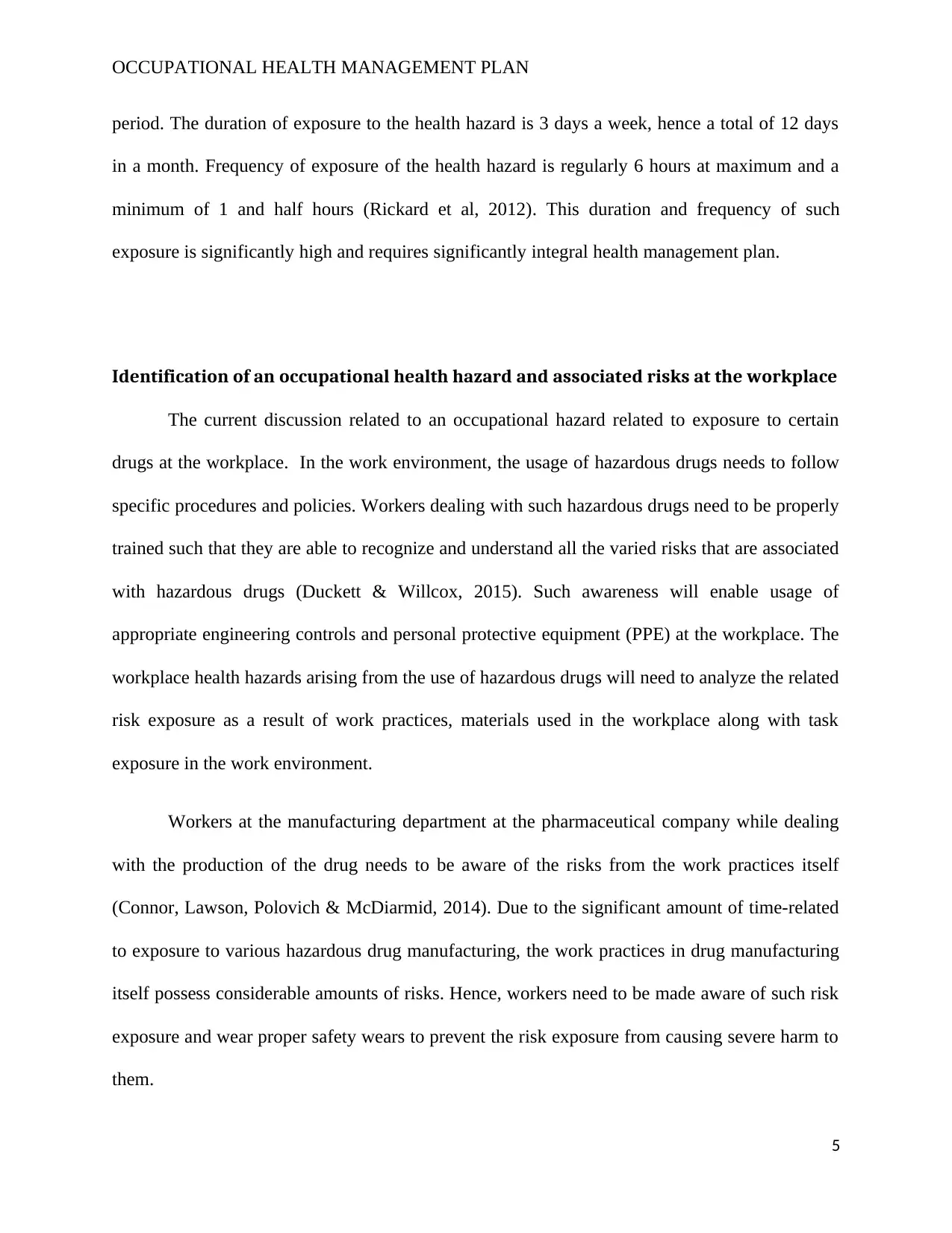
OCCUPATIONAL HEALTH MANAGEMENT PLAN
period. The duration of exposure to the health hazard is 3 days a week, hence a total of 12 days
in a month. Frequency of exposure of the health hazard is regularly 6 hours at maximum and a
minimum of 1 and half hours (Rickard et al, 2012). This duration and frequency of such
exposure is significantly high and requires significantly integral health management plan.
Identification of an occupational health hazard and associated risks at the workplace
The current discussion related to an occupational hazard related to exposure to certain
drugs at the workplace. In the work environment, the usage of hazardous drugs needs to follow
specific procedures and policies. Workers dealing with such hazardous drugs need to be properly
trained such that they are able to recognize and understand all the varied risks that are associated
with hazardous drugs (Duckett & Willcox, 2015). Such awareness will enable usage of
appropriate engineering controls and personal protective equipment (PPE) at the workplace. The
workplace health hazards arising from the use of hazardous drugs will need to analyze the related
risk exposure as a result of work practices, materials used in the workplace along with task
exposure in the work environment.
Workers at the manufacturing department at the pharmaceutical company while dealing
with the production of the drug needs to be aware of the risks from the work practices itself
(Connor, Lawson, Polovich & McDiarmid, 2014). Due to the significant amount of time-related
to exposure to various hazardous drug manufacturing, the work practices in drug manufacturing
itself possess considerable amounts of risks. Hence, workers need to be made aware of such risk
exposure and wear proper safety wears to prevent the risk exposure from causing severe harm to
them.
5
period. The duration of exposure to the health hazard is 3 days a week, hence a total of 12 days
in a month. Frequency of exposure of the health hazard is regularly 6 hours at maximum and a
minimum of 1 and half hours (Rickard et al, 2012). This duration and frequency of such
exposure is significantly high and requires significantly integral health management plan.
Identification of an occupational health hazard and associated risks at the workplace
The current discussion related to an occupational hazard related to exposure to certain
drugs at the workplace. In the work environment, the usage of hazardous drugs needs to follow
specific procedures and policies. Workers dealing with such hazardous drugs need to be properly
trained such that they are able to recognize and understand all the varied risks that are associated
with hazardous drugs (Duckett & Willcox, 2015). Such awareness will enable usage of
appropriate engineering controls and personal protective equipment (PPE) at the workplace. The
workplace health hazards arising from the use of hazardous drugs will need to analyze the related
risk exposure as a result of work practices, materials used in the workplace along with task
exposure in the work environment.
Workers at the manufacturing department at the pharmaceutical company while dealing
with the production of the drug needs to be aware of the risks from the work practices itself
(Connor, Lawson, Polovich & McDiarmid, 2014). Due to the significant amount of time-related
to exposure to various hazardous drug manufacturing, the work practices in drug manufacturing
itself possess considerable amounts of risks. Hence, workers need to be made aware of such risk
exposure and wear proper safety wears to prevent the risk exposure from causing severe harm to
them.
5
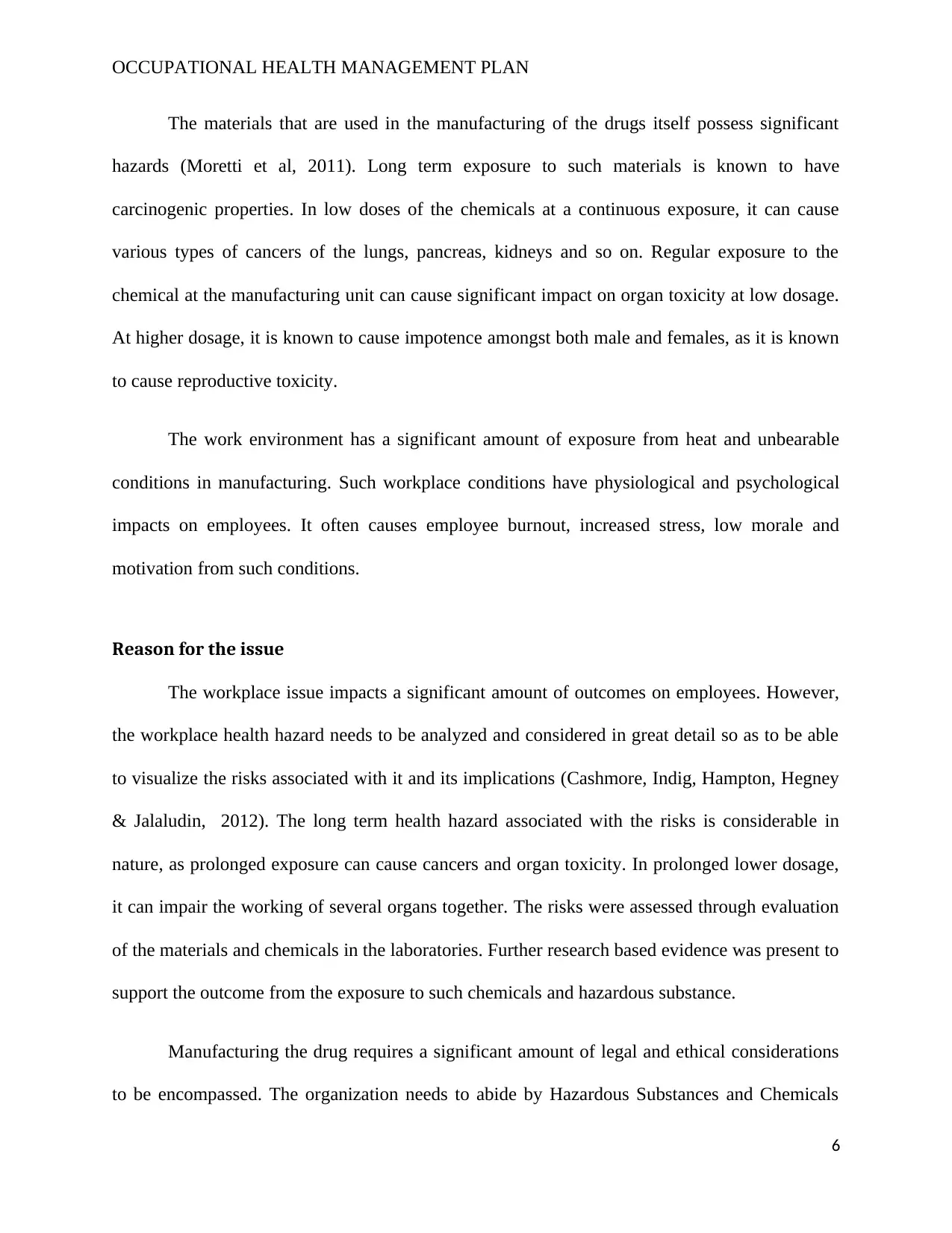
OCCUPATIONAL HEALTH MANAGEMENT PLAN
The materials that are used in the manufacturing of the drugs itself possess significant
hazards (Moretti et al, 2011). Long term exposure to such materials is known to have
carcinogenic properties. In low doses of the chemicals at a continuous exposure, it can cause
various types of cancers of the lungs, pancreas, kidneys and so on. Regular exposure to the
chemical at the manufacturing unit can cause significant impact on organ toxicity at low dosage.
At higher dosage, it is known to cause impotence amongst both male and females, as it is known
to cause reproductive toxicity.
The work environment has a significant amount of exposure from heat and unbearable
conditions in manufacturing. Such workplace conditions have physiological and psychological
impacts on employees. It often causes employee burnout, increased stress, low morale and
motivation from such conditions.
Reason for the issue
The workplace issue impacts a significant amount of outcomes on employees. However,
the workplace health hazard needs to be analyzed and considered in great detail so as to be able
to visualize the risks associated with it and its implications (Cashmore, Indig, Hampton, Hegney
& Jalaludin, 2012). The long term health hazard associated with the risks is considerable in
nature, as prolonged exposure can cause cancers and organ toxicity. In prolonged lower dosage,
it can impair the working of several organs together. The risks were assessed through evaluation
of the materials and chemicals in the laboratories. Further research based evidence was present to
support the outcome from the exposure to such chemicals and hazardous substance.
Manufacturing the drug requires a significant amount of legal and ethical considerations
to be encompassed. The organization needs to abide by Hazardous Substances and Chemicals
6
The materials that are used in the manufacturing of the drugs itself possess significant
hazards (Moretti et al, 2011). Long term exposure to such materials is known to have
carcinogenic properties. In low doses of the chemicals at a continuous exposure, it can cause
various types of cancers of the lungs, pancreas, kidneys and so on. Regular exposure to the
chemical at the manufacturing unit can cause significant impact on organ toxicity at low dosage.
At higher dosage, it is known to cause impotence amongst both male and females, as it is known
to cause reproductive toxicity.
The work environment has a significant amount of exposure from heat and unbearable
conditions in manufacturing. Such workplace conditions have physiological and psychological
impacts on employees. It often causes employee burnout, increased stress, low morale and
motivation from such conditions.
Reason for the issue
The workplace issue impacts a significant amount of outcomes on employees. However,
the workplace health hazard needs to be analyzed and considered in great detail so as to be able
to visualize the risks associated with it and its implications (Cashmore, Indig, Hampton, Hegney
& Jalaludin, 2012). The long term health hazard associated with the risks is considerable in
nature, as prolonged exposure can cause cancers and organ toxicity. In prolonged lower dosage,
it can impair the working of several organs together. The risks were assessed through evaluation
of the materials and chemicals in the laboratories. Further research based evidence was present to
support the outcome from the exposure to such chemicals and hazardous substance.
Manufacturing the drug requires a significant amount of legal and ethical considerations
to be encompassed. The organization needs to abide by Hazardous Substances and Chemicals
6
⊘ This is a preview!⊘
Do you want full access?
Subscribe today to unlock all pages.

Trusted by 1+ million students worldwide
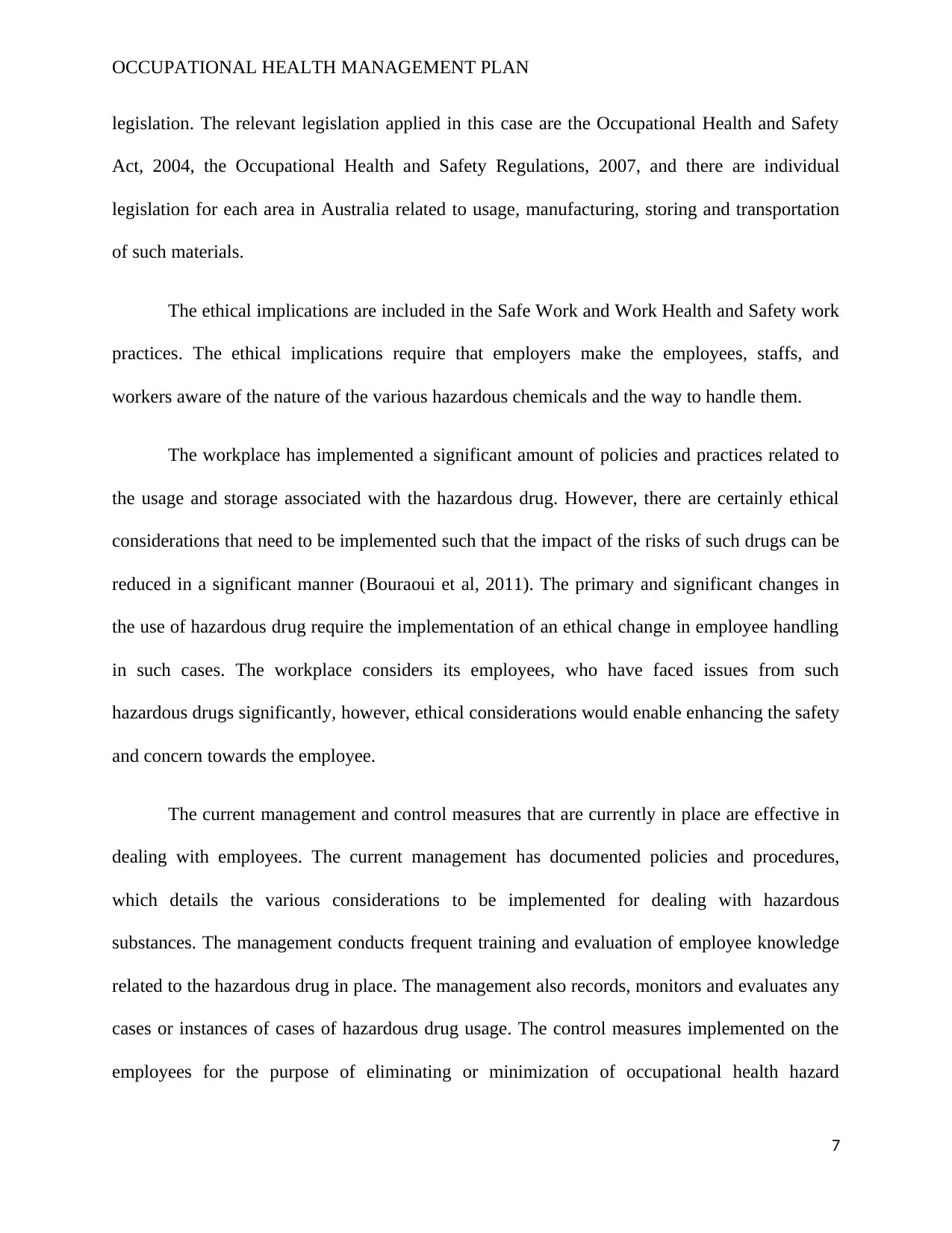
OCCUPATIONAL HEALTH MANAGEMENT PLAN
legislation. The relevant legislation applied in this case are the Occupational Health and Safety
Act, 2004, the Occupational Health and Safety Regulations, 2007, and there are individual
legislation for each area in Australia related to usage, manufacturing, storing and transportation
of such materials.
The ethical implications are included in the Safe Work and Work Health and Safety work
practices. The ethical implications require that employers make the employees, staffs, and
workers aware of the nature of the various hazardous chemicals and the way to handle them.
The workplace has implemented a significant amount of policies and practices related to
the usage and storage associated with the hazardous drug. However, there are certainly ethical
considerations that need to be implemented such that the impact of the risks of such drugs can be
reduced in a significant manner (Bouraoui et al, 2011). The primary and significant changes in
the use of hazardous drug require the implementation of an ethical change in employee handling
in such cases. The workplace considers its employees, who have faced issues from such
hazardous drugs significantly, however, ethical considerations would enable enhancing the safety
and concern towards the employee.
The current management and control measures that are currently in place are effective in
dealing with employees. The current management has documented policies and procedures,
which details the various considerations to be implemented for dealing with hazardous
substances. The management conducts frequent training and evaluation of employee knowledge
related to the hazardous drug in place. The management also records, monitors and evaluates any
cases or instances of cases of hazardous drug usage. The control measures implemented on the
employees for the purpose of eliminating or minimization of occupational health hazard
7
legislation. The relevant legislation applied in this case are the Occupational Health and Safety
Act, 2004, the Occupational Health and Safety Regulations, 2007, and there are individual
legislation for each area in Australia related to usage, manufacturing, storing and transportation
of such materials.
The ethical implications are included in the Safe Work and Work Health and Safety work
practices. The ethical implications require that employers make the employees, staffs, and
workers aware of the nature of the various hazardous chemicals and the way to handle them.
The workplace has implemented a significant amount of policies and practices related to
the usage and storage associated with the hazardous drug. However, there are certainly ethical
considerations that need to be implemented such that the impact of the risks of such drugs can be
reduced in a significant manner (Bouraoui et al, 2011). The primary and significant changes in
the use of hazardous drug require the implementation of an ethical change in employee handling
in such cases. The workplace considers its employees, who have faced issues from such
hazardous drugs significantly, however, ethical considerations would enable enhancing the safety
and concern towards the employee.
The current management and control measures that are currently in place are effective in
dealing with employees. The current management has documented policies and procedures,
which details the various considerations to be implemented for dealing with hazardous
substances. The management conducts frequent training and evaluation of employee knowledge
related to the hazardous drug in place. The management also records, monitors and evaluates any
cases or instances of cases of hazardous drug usage. The control measures implemented on the
employees for the purpose of eliminating or minimization of occupational health hazard
7
Paraphrase This Document
Need a fresh take? Get an instant paraphrase of this document with our AI Paraphraser
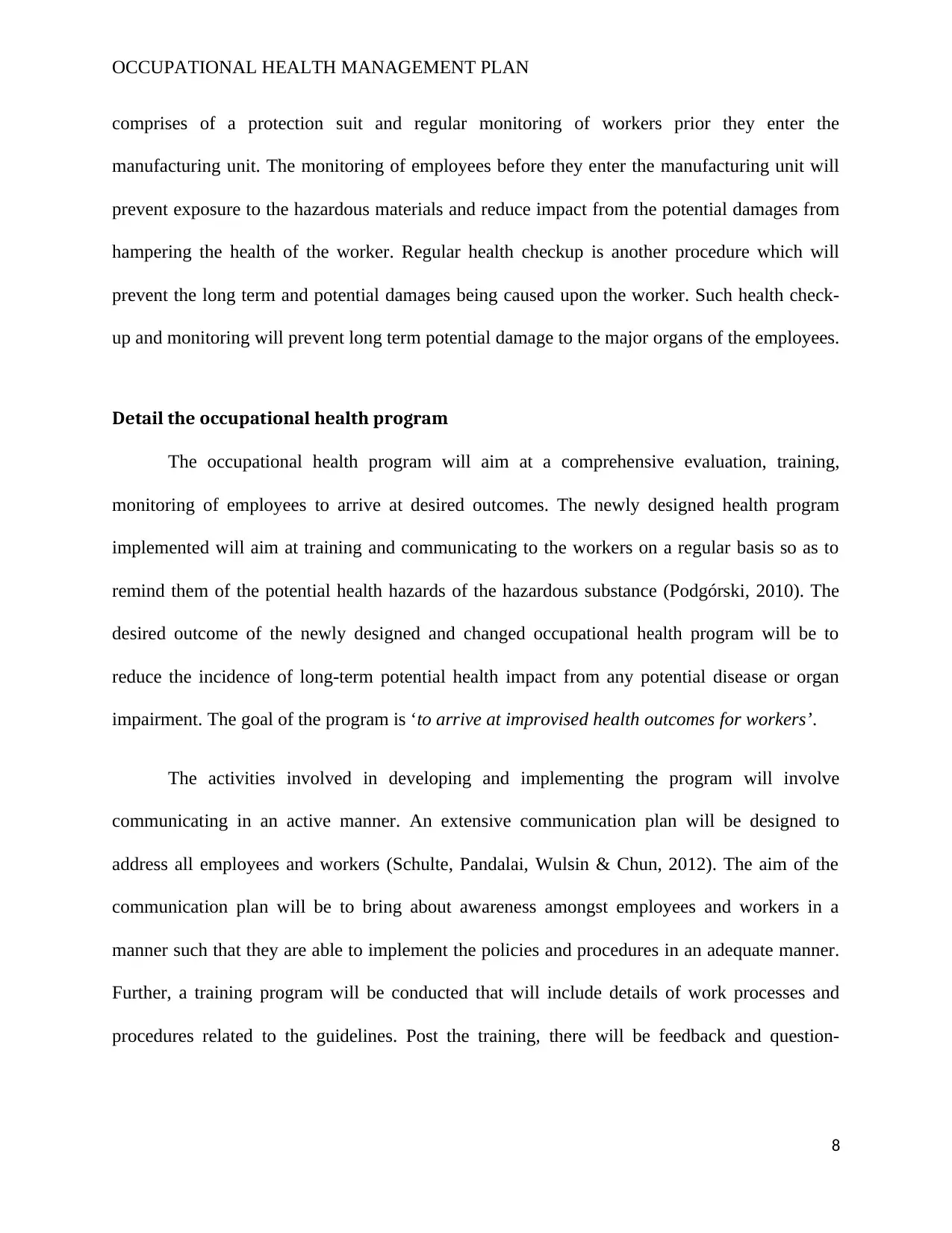
OCCUPATIONAL HEALTH MANAGEMENT PLAN
comprises of a protection suit and regular monitoring of workers prior they enter the
manufacturing unit. The monitoring of employees before they enter the manufacturing unit will
prevent exposure to the hazardous materials and reduce impact from the potential damages from
hampering the health of the worker. Regular health checkup is another procedure which will
prevent the long term and potential damages being caused upon the worker. Such health check-
up and monitoring will prevent long term potential damage to the major organs of the employees.
Detail the occupational health program
The occupational health program will aim at a comprehensive evaluation, training,
monitoring of employees to arrive at desired outcomes. The newly designed health program
implemented will aim at training and communicating to the workers on a regular basis so as to
remind them of the potential health hazards of the hazardous substance (Podgórski, 2010). The
desired outcome of the newly designed and changed occupational health program will be to
reduce the incidence of long-term potential health impact from any potential disease or organ
impairment. The goal of the program is ‘to arrive at improvised health outcomes for workers’.
The activities involved in developing and implementing the program will involve
communicating in an active manner. An extensive communication plan will be designed to
address all employees and workers (Schulte, Pandalai, Wulsin & Chun, 2012). The aim of the
communication plan will be to bring about awareness amongst employees and workers in a
manner such that they are able to implement the policies and procedures in an adequate manner.
Further, a training program will be conducted that will include details of work processes and
procedures related to the guidelines. Post the training, there will be feedback and question-
8
comprises of a protection suit and regular monitoring of workers prior they enter the
manufacturing unit. The monitoring of employees before they enter the manufacturing unit will
prevent exposure to the hazardous materials and reduce impact from the potential damages from
hampering the health of the worker. Regular health checkup is another procedure which will
prevent the long term and potential damages being caused upon the worker. Such health check-
up and monitoring will prevent long term potential damage to the major organs of the employees.
Detail the occupational health program
The occupational health program will aim at a comprehensive evaluation, training,
monitoring of employees to arrive at desired outcomes. The newly designed health program
implemented will aim at training and communicating to the workers on a regular basis so as to
remind them of the potential health hazards of the hazardous substance (Podgórski, 2010). The
desired outcome of the newly designed and changed occupational health program will be to
reduce the incidence of long-term potential health impact from any potential disease or organ
impairment. The goal of the program is ‘to arrive at improvised health outcomes for workers’.
The activities involved in developing and implementing the program will involve
communicating in an active manner. An extensive communication plan will be designed to
address all employees and workers (Schulte, Pandalai, Wulsin & Chun, 2012). The aim of the
communication plan will be to bring about awareness amongst employees and workers in a
manner such that they are able to implement the policies and procedures in an adequate manner.
Further, a training program will be conducted that will include details of work processes and
procedures related to the guidelines. Post the training, there will be feedback and question-
8
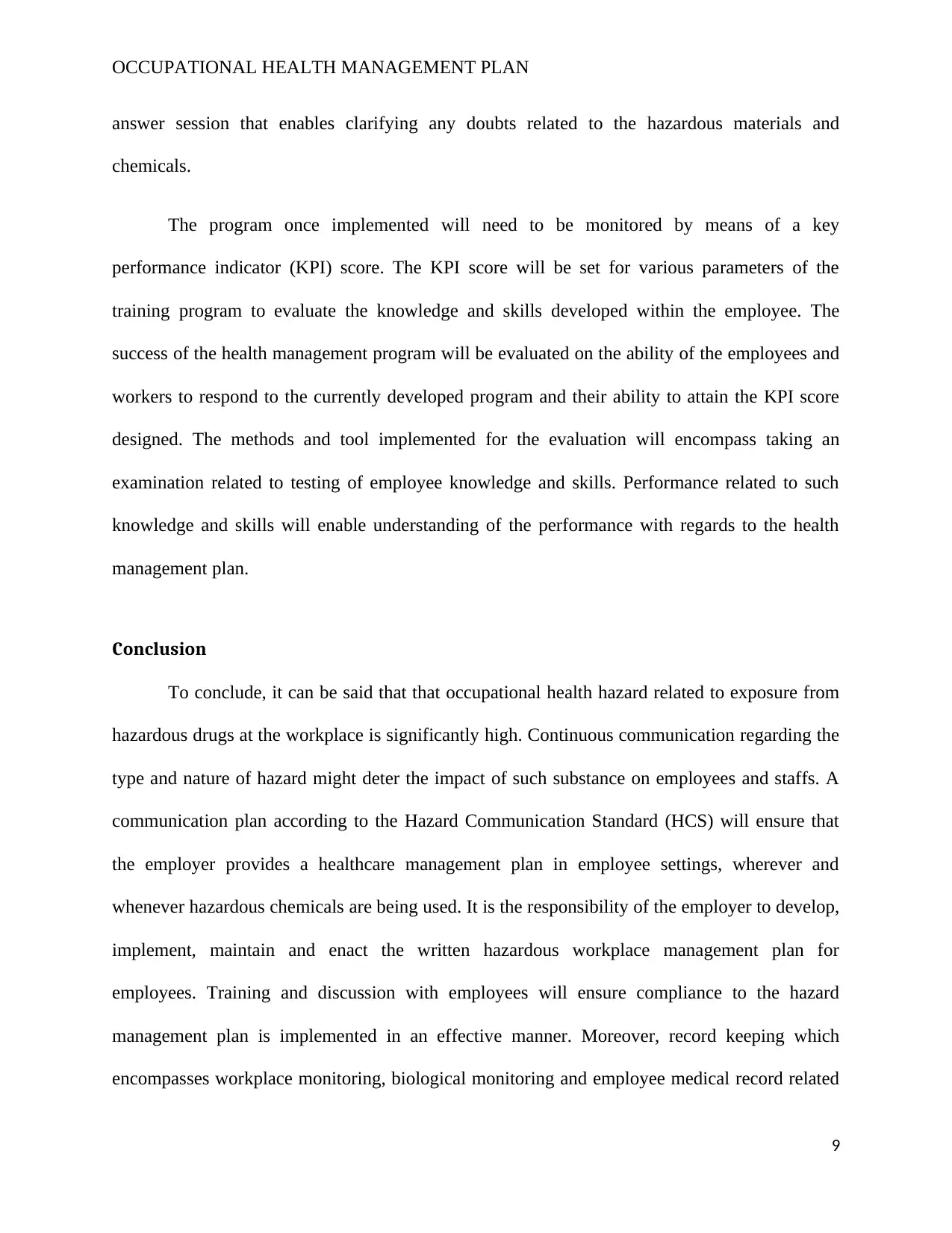
OCCUPATIONAL HEALTH MANAGEMENT PLAN
answer session that enables clarifying any doubts related to the hazardous materials and
chemicals.
The program once implemented will need to be monitored by means of a key
performance indicator (KPI) score. The KPI score will be set for various parameters of the
training program to evaluate the knowledge and skills developed within the employee. The
success of the health management program will be evaluated on the ability of the employees and
workers to respond to the currently developed program and their ability to attain the KPI score
designed. The methods and tool implemented for the evaluation will encompass taking an
examination related to testing of employee knowledge and skills. Performance related to such
knowledge and skills will enable understanding of the performance with regards to the health
management plan.
Conclusion
To conclude, it can be said that that occupational health hazard related to exposure from
hazardous drugs at the workplace is significantly high. Continuous communication regarding the
type and nature of hazard might deter the impact of such substance on employees and staffs. A
communication plan according to the Hazard Communication Standard (HCS) will ensure that
the employer provides a healthcare management plan in employee settings, wherever and
whenever hazardous chemicals are being used. It is the responsibility of the employer to develop,
implement, maintain and enact the written hazardous workplace management plan for
employees. Training and discussion with employees will ensure compliance to the hazard
management plan is implemented in an effective manner. Moreover, record keeping which
encompasses workplace monitoring, biological monitoring and employee medical record related
9
answer session that enables clarifying any doubts related to the hazardous materials and
chemicals.
The program once implemented will need to be monitored by means of a key
performance indicator (KPI) score. The KPI score will be set for various parameters of the
training program to evaluate the knowledge and skills developed within the employee. The
success of the health management program will be evaluated on the ability of the employees and
workers to respond to the currently developed program and their ability to attain the KPI score
designed. The methods and tool implemented for the evaluation will encompass taking an
examination related to testing of employee knowledge and skills. Performance related to such
knowledge and skills will enable understanding of the performance with regards to the health
management plan.
Conclusion
To conclude, it can be said that that occupational health hazard related to exposure from
hazardous drugs at the workplace is significantly high. Continuous communication regarding the
type and nature of hazard might deter the impact of such substance on employees and staffs. A
communication plan according to the Hazard Communication Standard (HCS) will ensure that
the employer provides a healthcare management plan in employee settings, wherever and
whenever hazardous chemicals are being used. It is the responsibility of the employer to develop,
implement, maintain and enact the written hazardous workplace management plan for
employees. Training and discussion with employees will ensure compliance to the hazard
management plan is implemented in an effective manner. Moreover, record keeping which
encompasses workplace monitoring, biological monitoring and employee medical record related
9
⊘ This is a preview!⊘
Do you want full access?
Subscribe today to unlock all pages.

Trusted by 1+ million students worldwide
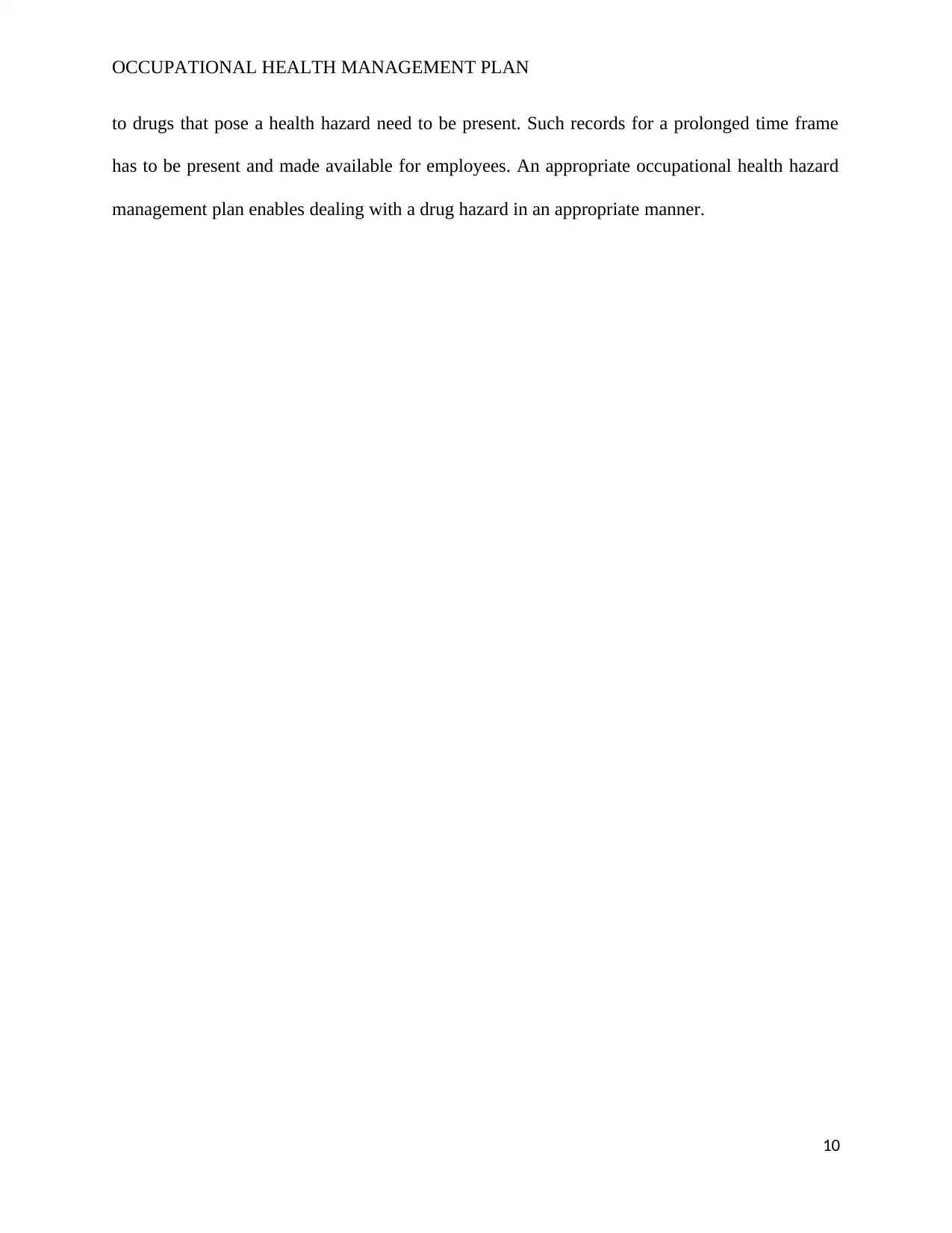
OCCUPATIONAL HEALTH MANAGEMENT PLAN
to drugs that pose a health hazard need to be present. Such records for a prolonged time frame
has to be present and made available for employees. An appropriate occupational health hazard
management plan enables dealing with a drug hazard in an appropriate manner.
10
to drugs that pose a health hazard need to be present. Such records for a prolonged time frame
has to be present and made available for employees. An appropriate occupational health hazard
management plan enables dealing with a drug hazard in an appropriate manner.
10
Paraphrase This Document
Need a fresh take? Get an instant paraphrase of this document with our AI Paraphraser
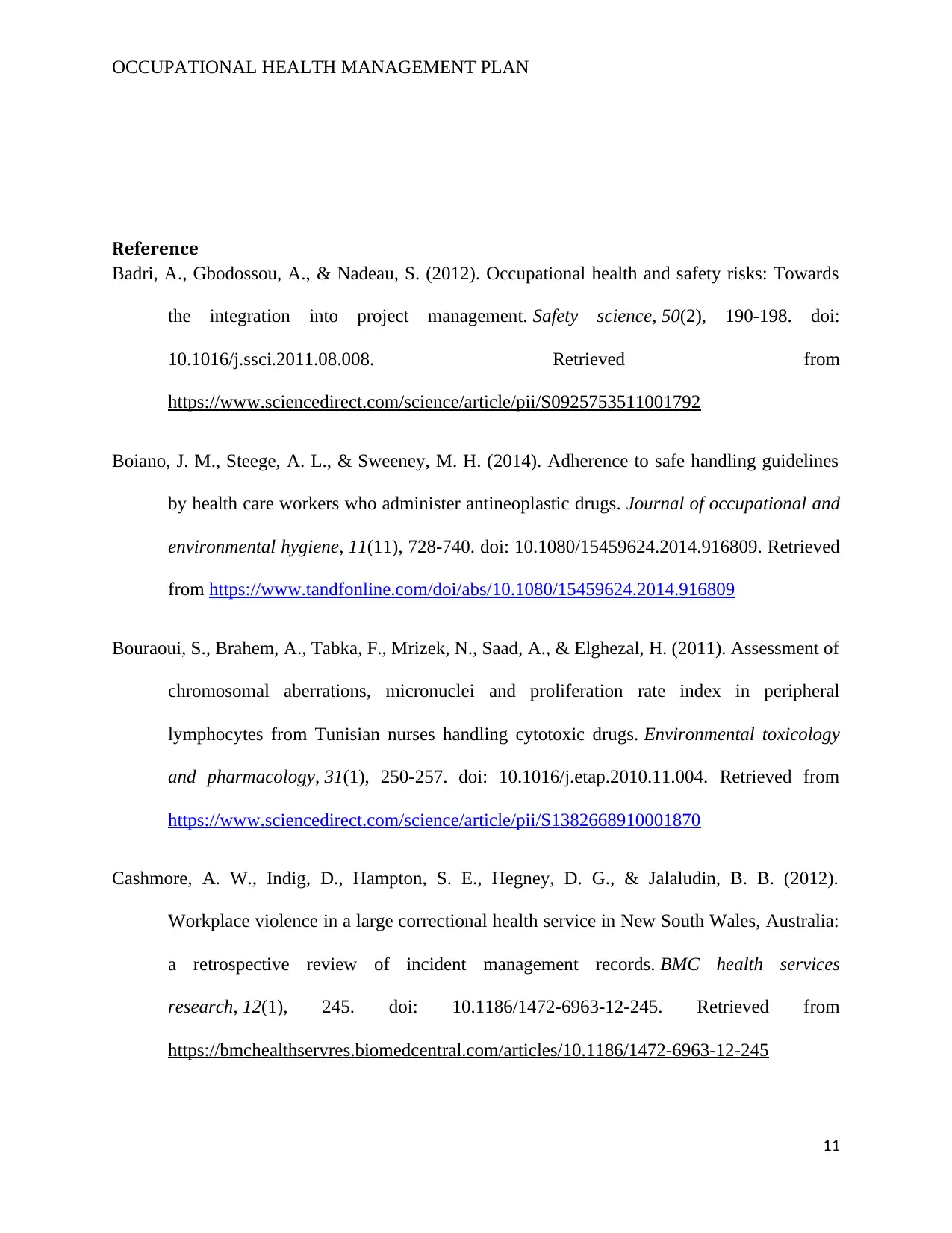
OCCUPATIONAL HEALTH MANAGEMENT PLAN
Reference
Badri, A., Gbodossou, A., & Nadeau, S. (2012). Occupational health and safety risks: Towards
the integration into project management. Safety science, 50(2), 190-198. doi:
10.1016/j.ssci.2011.08.008. Retrieved from
https://www.sciencedirect.com/science/article/pii/S0925753511001792
Boiano, J. M., Steege, A. L., & Sweeney, M. H. (2014). Adherence to safe handling guidelines
by health care workers who administer antineoplastic drugs. Journal of occupational and
environmental hygiene, 11(11), 728-740. doi: 10.1080/15459624.2014.916809. Retrieved
from https://www.tandfonline.com/doi/abs/10.1080/15459624.2014.916809
Bouraoui, S., Brahem, A., Tabka, F., Mrizek, N., Saad, A., & Elghezal, H. (2011). Assessment of
chromosomal aberrations, micronuclei and proliferation rate index in peripheral
lymphocytes from Tunisian nurses handling cytotoxic drugs. Environmental toxicology
and pharmacology, 31(1), 250-257. doi: 10.1016/j.etap.2010.11.004. Retrieved from
https://www.sciencedirect.com/science/article/pii/S1382668910001870
Cashmore, A. W., Indig, D., Hampton, S. E., Hegney, D. G., & Jalaludin, B. B. (2012).
Workplace violence in a large correctional health service in New South Wales, Australia:
a retrospective review of incident management records. BMC health services
research, 12(1), 245. doi: 10.1186/1472-6963-12-245. Retrieved from
https://bmchealthservres.biomedcentral.com/articles/10.1186/1472-6963-12-245
11
Reference
Badri, A., Gbodossou, A., & Nadeau, S. (2012). Occupational health and safety risks: Towards
the integration into project management. Safety science, 50(2), 190-198. doi:
10.1016/j.ssci.2011.08.008. Retrieved from
https://www.sciencedirect.com/science/article/pii/S0925753511001792
Boiano, J. M., Steege, A. L., & Sweeney, M. H. (2014). Adherence to safe handling guidelines
by health care workers who administer antineoplastic drugs. Journal of occupational and
environmental hygiene, 11(11), 728-740. doi: 10.1080/15459624.2014.916809. Retrieved
from https://www.tandfonline.com/doi/abs/10.1080/15459624.2014.916809
Bouraoui, S., Brahem, A., Tabka, F., Mrizek, N., Saad, A., & Elghezal, H. (2011). Assessment of
chromosomal aberrations, micronuclei and proliferation rate index in peripheral
lymphocytes from Tunisian nurses handling cytotoxic drugs. Environmental toxicology
and pharmacology, 31(1), 250-257. doi: 10.1016/j.etap.2010.11.004. Retrieved from
https://www.sciencedirect.com/science/article/pii/S1382668910001870
Cashmore, A. W., Indig, D., Hampton, S. E., Hegney, D. G., & Jalaludin, B. B. (2012).
Workplace violence in a large correctional health service in New South Wales, Australia:
a retrospective review of incident management records. BMC health services
research, 12(1), 245. doi: 10.1186/1472-6963-12-245. Retrieved from
https://bmchealthservres.biomedcentral.com/articles/10.1186/1472-6963-12-245
11
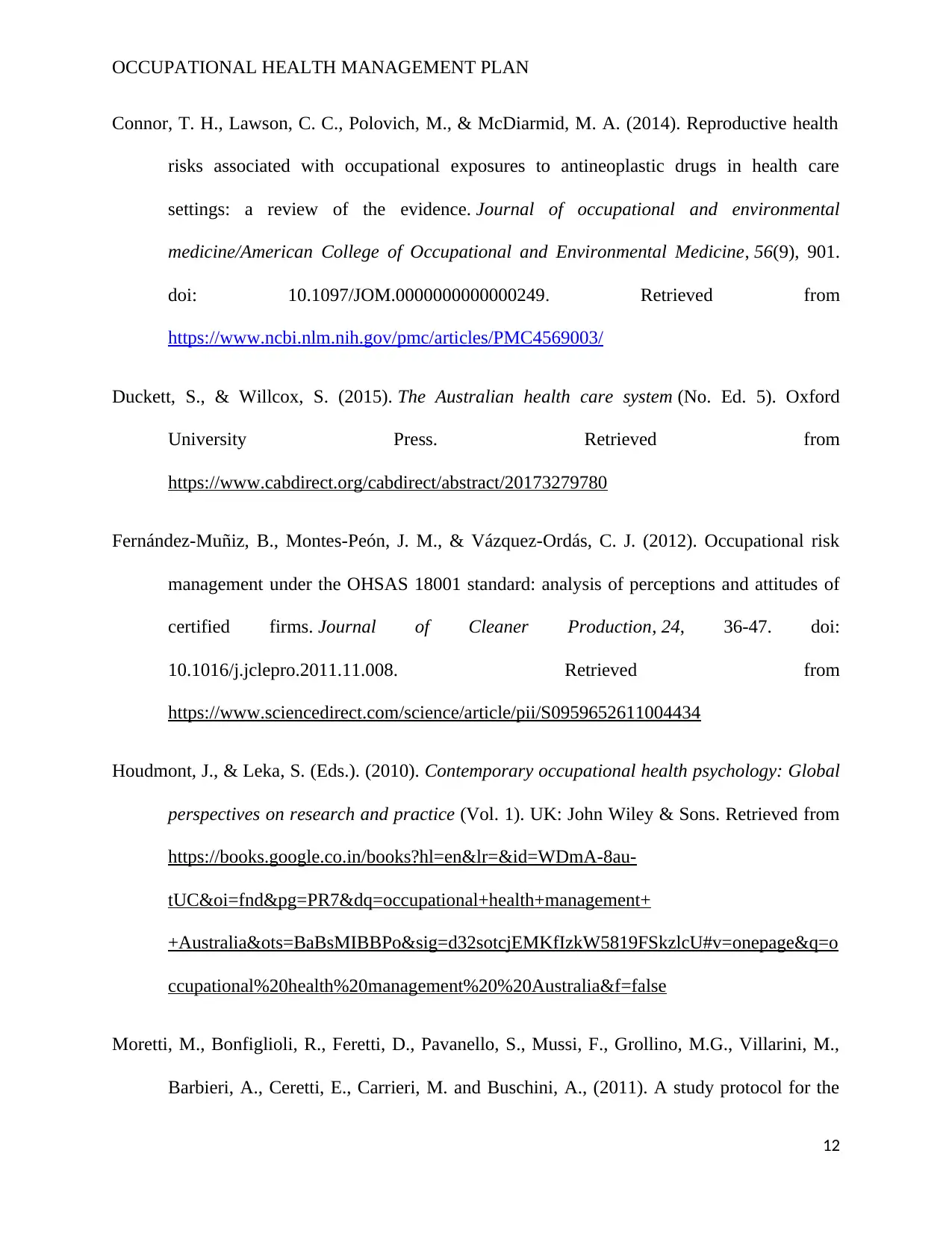
OCCUPATIONAL HEALTH MANAGEMENT PLAN
Connor, T. H., Lawson, C. C., Polovich, M., & McDiarmid, M. A. (2014). Reproductive health
risks associated with occupational exposures to antineoplastic drugs in health care
settings: a review of the evidence. Journal of occupational and environmental
medicine/American College of Occupational and Environmental Medicine, 56(9), 901.
doi: 10.1097/JOM.0000000000000249. Retrieved from
https://www.ncbi.nlm.nih.gov/pmc/articles/PMC4569003/
Duckett, S., & Willcox, S. (2015). The Australian health care system (No. Ed. 5). Oxford
University Press. Retrieved from
https://www.cabdirect.org/cabdirect/abstract/20173279780
Fernández-Muñiz, B., Montes-Peón, J. M., & Vázquez-Ordás, C. J. (2012). Occupational risk
management under the OHSAS 18001 standard: analysis of perceptions and attitudes of
certified firms. Journal of Cleaner Production, 24, 36-47. doi:
10.1016/j.jclepro.2011.11.008. Retrieved from
https://www.sciencedirect.com/science/article/pii/S0959652611004434
Houdmont, J., & Leka, S. (Eds.). (2010). Contemporary occupational health psychology: Global
perspectives on research and practice (Vol. 1). UK: John Wiley & Sons. Retrieved from
https://books.google.co.in/books?hl=en&lr=&id=WDmA-8au-
tUC&oi=fnd&pg=PR7&dq=occupational+health+management+
+Australia&ots=BaBsMIBBPo&sig=d32sotcjEMKfIzkW5819FSkzlcU#v=onepage&q=o
ccupational%20health%20management%20%20Australia&f=false
Moretti, M., Bonfiglioli, R., Feretti, D., Pavanello, S., Mussi, F., Grollino, M.G., Villarini, M.,
Barbieri, A., Ceretti, E., Carrieri, M. and Buschini, A., (2011). A study protocol for the
12
Connor, T. H., Lawson, C. C., Polovich, M., & McDiarmid, M. A. (2014). Reproductive health
risks associated with occupational exposures to antineoplastic drugs in health care
settings: a review of the evidence. Journal of occupational and environmental
medicine/American College of Occupational and Environmental Medicine, 56(9), 901.
doi: 10.1097/JOM.0000000000000249. Retrieved from
https://www.ncbi.nlm.nih.gov/pmc/articles/PMC4569003/
Duckett, S., & Willcox, S. (2015). The Australian health care system (No. Ed. 5). Oxford
University Press. Retrieved from
https://www.cabdirect.org/cabdirect/abstract/20173279780
Fernández-Muñiz, B., Montes-Peón, J. M., & Vázquez-Ordás, C. J. (2012). Occupational risk
management under the OHSAS 18001 standard: analysis of perceptions and attitudes of
certified firms. Journal of Cleaner Production, 24, 36-47. doi:
10.1016/j.jclepro.2011.11.008. Retrieved from
https://www.sciencedirect.com/science/article/pii/S0959652611004434
Houdmont, J., & Leka, S. (Eds.). (2010). Contemporary occupational health psychology: Global
perspectives on research and practice (Vol. 1). UK: John Wiley & Sons. Retrieved from
https://books.google.co.in/books?hl=en&lr=&id=WDmA-8au-
tUC&oi=fnd&pg=PR7&dq=occupational+health+management+
+Australia&ots=BaBsMIBBPo&sig=d32sotcjEMKfIzkW5819FSkzlcU#v=onepage&q=o
ccupational%20health%20management%20%20Australia&f=false
Moretti, M., Bonfiglioli, R., Feretti, D., Pavanello, S., Mussi, F., Grollino, M.G., Villarini, M.,
Barbieri, A., Ceretti, E., Carrieri, M. and Buschini, A., (2011). A study protocol for the
12
⊘ This is a preview!⊘
Do you want full access?
Subscribe today to unlock all pages.

Trusted by 1+ million students worldwide
1 out of 14
Related Documents
Your All-in-One AI-Powered Toolkit for Academic Success.
+13062052269
info@desklib.com
Available 24*7 on WhatsApp / Email
![[object Object]](/_next/static/media/star-bottom.7253800d.svg)
Unlock your academic potential
Copyright © 2020–2025 A2Z Services. All Rights Reserved. Developed and managed by ZUCOL.





